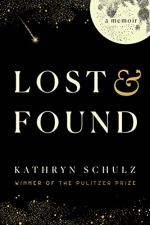|
This section contains 855 words (approx. 3 pages at 400 words per page) |

|
Lost & Found Summary & Study Guide Description
Lost & Found Summary & Study Guide includes comprehensive information and analysis to help you understand the book. This study guide contains the following sections:
This detailed literature summary also contains Topics for Discussion on Lost & Found by Kathryn Schulz.
The following version of this book was used to create the guide: Schulz, Kathryn. Lost & Found. Random House, 2022.
Schulz's memoir has three parts, which together make up the book's title: Part I. Lost; Part II: Found; Part III: And. Each is structured around deep rumination on the full meaning of each word, and how the author has had to confront the complexity and depth embedded in each concept within the context of her life at different stages.
In Part I. Lost, Schulz begins her memoir by describing the prolonged experience of her father's death. She foregrounds this by grappling with various explanations of loss: evolutionary, psychological, philosophical, etymological, and mythological. In so doing, she recounts her father's lineage as the son of a Holocaust survivor who was exiled first to Tel Aviv and then eventually to the United States in the aftermath of World War II. In thinking through her grandmother's experience of exile and its ramifications for her family, Schulz toys with the imagined idea of a “Valley of Lost Things” in which obsolete tokens of time's passage coexist in tranquility.
Schulz goes on to describe the time she and her family spent in the hospital awaiting her father's prognosis. Eventually the doctors tell the family they must make a decision as to how to proceed with her father's terminal case and they elect to place him in hospice care. This ordeal in the hospital is explained as mundanity punctuated by intense anxiety and dread. By contrast, the time she spends with her father in hospice care, during the remaining days of his life, are described as both comforting and understandable. During this period she reflects on her father's liveliness and the salient qualities that make his life still ongoing. She describes his assisted breathing machine, which inflates his chest and keeps him alive.
Eventually, she and her family decide to take him off life support. The final memory she has of his life is her mother tenderly supporting his body with gentle acceptance of his loss. Schulz then proceeds to describe the mourning process, marked by unexpected, individualized reactions to its incomprehensibility. She becomes suddenly clumsy in her daily routines, and almost delirious in her disorientation. At times her grief is even humorous, as she ponders the absence of her father for what it truly means to her: the loss of seeing the world through his unique eyes.
In Part II: Found, the focus shifts abruptly to description of the author's experience meeting and falling in love with her partner, which occurred the year before her father's death. She ruminates on the meaning of finding and being found, first by anecdote a boy who discovers a fallen meteorite, and then by discussion of finding love. Schulz introduces, C., her partner, and recounts the happenstance in which they met, how they fell in love, and the fears and anxieties each have in their intimacy. Schulz discusses their differing class backgrounds: hers is middle class, from suburban Ohio; while C. is from a more rural working class part of Maryland. She explains this in the cathartic context of C. helping her clean out her childhood home.
The second part of the memoir ends with Schulz revealing that C.'s father was the boy in the story who found the fallen meteorite at the beginning of the section.
Part III: And picks up the story of the fallen meteorite and reflects on astronomical history of the earth, finally fixating on a singular planetary spot where C. and the author had their wedding. Their spiritual and romantic conjoining is imagined within the course of a deeper contemplation of the ampersand as an elemental symbol of conjunction itself.
The day of their wedding is marked by meteorological uncertainty, as a tornado warning is in effect. But the joyousness of the occasion seems to overrule this natural threat, and the day proceeds splendidly, as C. and Schulz's public and personal conjunction is consummated with throngs of family and friends.
Following the wedding ceremony, however, the predicted storm does finally arrive. Yet Schulz recounts having felt an exuberant delight standing betrothed in the rain. Merriment and affection ensue for the rest of the day, until C. realizes that they have not yet signed their marriage certificate. Even this unexpected event, however, finds a graceful resolution, as the narrator rouses their officiant to formally certify their marriage and the celebration continues into the night.
Schulz ends the book in the present, self-reflexively divulging that she had a photograph of her and her mother at Chesapeake Bay beside her while writing her memoir. In so doing, she focuses attention on the absence of her father in the frame and considers how her family has been remapped since his death. She then reveals that she and C. are expecting a baby together, and reflects on her father's quip that, through raising a child, one attains a tiny bit of eternity. This, as part of a reflection on the vastness of the universe and minuscule experience of human loss and finding within it, closes the memoir on a modest but hopeful note.
Read more from the Study Guide
|
This section contains 855 words (approx. 3 pages at 400 words per page) |

|



